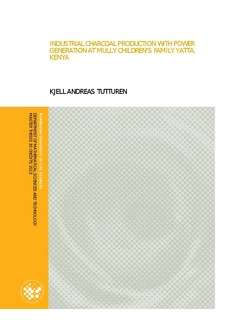| dc.description.abstract | This thesis examines the possibility for industrial charcoal production with power generation at Mully Children’s Family (MCF) Yatta, located in rural Kenya. In Kenya, most of the
population use firewood or charcoal for food preparation. In rural areas, where unsustainable firewood consumption is most common, it would be beneficial to use sustainably produced charcoal instead, due to health aspects and to reduce deforestation. With the forest biomass potential fully established MCF will annually have around 1000 ton dry biomass available.
Different technologies for industrial charcoal production have been described and the Pressvess twin retort is found to be a suitable design for MCF Yatta. This is a twin retort with two externally heated charge cylinders heated by a common combustion chamber. The annual potential for this type is 140 ton charcoal generating 520 MWh of accessible heat.
However, it is a batch process which is not ideal to combine with power generation and therefore two alternative designs have been proposed.
One option is to have interchangeable charge cylinders, heated with the pyrolysis gas from the opposite charge cylinder, enabling the Pressvess twin retort to be semi continuous and generate smoother heat. The potential for this design is annually 340 ton charcoal and 1320
MWh of accessible heat. Another option is to have two Pressvess twin retorts ran in counter phase and in this way simulate a semi continuous process. This will require two units, giving higher heat losses, but it may be easier than enabling the unit to tolerate interchangeable charge cylinders. This option may annually produce 280 ton of charcoal and generate 1040 MWh of accessible heat.
Power generation technologies believed to be combinable with charcoal production have been described. Steam engine, steam turbine or an organic rankine cycle (ORC) turbine are closed cycle technologies that is suitable for the small scale production at MCF Yatta. Thermal efficiencies have been calculated for suitable working fluids for the ORC turbine and different parameters for steam. With a thermal storage, as a buffer between the charcoal production and the units utilizing the heat, a low temperature of the working fluid is preferable and with this in mind R245fa will be a good choice. An ORC turbine will be able to deliver a maximum of 27 kWe, with heat from two charcoal production units and 33 kWe , with heat from a modified charcoal production unit. This will match the average electricity consumption of MCF Yatta well, which is 30 kWe.
At MCF Yatta, one Pressvess twin retort may be install before the forest is fully established. The excess heat may be used to supply hot showers. When the biomass potential is reached
the a semi continuous charcoal production should be established, and an ORC-turbine may be integrated. | no_NO |
